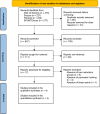Effects of Maturation Stage on Sprinting Speed Adaptations to Plyometric Jump Training in Youth Male Team Sports Players: A Systematic Review and Meta-Analysis
- PMID: 35586483
- PMCID: PMC9109897
- DOI: 10.2147/OAJSM.S283662
Effects of Maturation Stage on Sprinting Speed Adaptations to Plyometric Jump Training in Youth Male Team Sports Players: A Systematic Review and Meta-Analysis
Abstract
Purpose: To determine the effects of maturation stage (eg, classified in the same intervention protocol as early-, and late-mature) on linear sprinting speed adaptations to plyometric jump training (PJT) in youth (aged <18 years) male team sports players.
Patients and methods: Eligibility criteria was determined based on PICOS: (P) healthy youth male team sport players classified in the same intervention protocol in ≥2 maturation-related categories, based on a recognized maturation stage-determination method, including (but not limited to) Tanner stage; peak height velocity (eg, Mirwald method); radiography-based method (eg, Fels method); (I) athletes exposed to PJT with a minimum of 4 weeks duration; (C) athletes non-exposed to PJT (non-dedicated intervention, ie, only field-based regular training) or performing a parallel intervention not-related with PJT organized by maturation levels; (O) sprinting speed (eg, time, maximal sprint speed) measured in any linear sprint test trajectories before and after the intervention; (S) only randomized controlled and/or parallel trials. Searches were conducted on December 2021 in EMBASE, PubMed, Scopus, SPORTDiscus and Web of Science, restricted to Portuguese, Spanish and English languages, with no restrictions regarding publication date, and no filters applied. The PEDro scale was used to assess the risk of bias in the included studies. Meta-analysis was computed using the inverse variance random-effects model. The significance level was set at p < 0.05.
Results: The search identified 1219 titles. From those, four studies were selected for qualitative and quantitative synthesis. Four studies provided data for sprinting performance, involving 10 experimental and 8 control groups showing a small effect of trained participants on sprinting performance (ES = 0.31; p = 0.064; I2 = 41.3%) when compared to controls. No significant moderator effect was noted for somatic maturity (p = 0.473 between groups).
Conclusion: PJT had no significant effect on sprinting performance, although the inclusion criteria partially may explain that.
Keywords: athletic performance; plyometric exercise; puberty; team sports; youth sports.
© 2022 Silva et al.
Conflict of interest statement
The authors report no conflicts of interest in this work.
Figures



Similar articles
-
Plyometric-Jump Training Effects on Physical Fitness and Sport-Specific Performance According to Maturity: A Systematic Review with Meta-analysis.Sports Med Open. 2023 Apr 10;9(1):23. doi: 10.1186/s40798-023-00568-6. Sports Med Open. 2023. PMID: 37036542 Free PMC article.
-
Effects of Plyometric Jump Training on Measures of Physical Fitness and Sport-Specific Performance of Water Sports Athletes: A Systematic Review with Meta-analysis.Sports Med Open. 2022 Aug 29;8(1):108. doi: 10.1186/s40798-022-00502-2. Sports Med Open. 2022. PMID: 36036301 Free PMC article.
-
Effects of Plyometric Jump Training on the Reactive Strength Index in Healthy Individuals Across the Lifespan: A Systematic Review with Meta-analysis.Sports Med. 2023 May;53(5):1029-1053. doi: 10.1007/s40279-023-01825-0. Epub 2023 Mar 11. Sports Med. 2023. PMID: 36906633 Free PMC article.
-
Effects of Plyometric Jump Training on Jump and Sprint Performance in Young Male Soccer Players: A Systematic Review and Meta-analysis.Sports Med. 2020 Dec;50(12):2125-2143. doi: 10.1007/s40279-020-01337-1. Sports Med. 2020. PMID: 32915430
-
Effects of Plyometric Jump Training on Balance Performance in Healthy Participants: A Systematic Review With Meta-Analysis.Front Physiol. 2021 Oct 20;12:730945. doi: 10.3389/fphys.2021.730945. eCollection 2021. Front Physiol. 2021. PMID: 34744772 Free PMC article.
Cited by
-
Enhancing clarity and methodological rigor in umbrella reviews.Ann Med Surg (Lond). 2024 Sep 5;86(10):6352-6354. doi: 10.1097/MS9.0000000000002536. eCollection 2024 Oct. Ann Med Surg (Lond). 2024. PMID: 39359834 Free PMC article. No abstract available.
-
Maturation-specific enhancements in lower extremity explosive strength following plyometric training in adolescent soccer players: A systematic review and meta-analysis.Heliyon. 2024 Jun 15;10(12):e33063. doi: 10.1016/j.heliyon.2024.e33063. eCollection 2024 Jun 30. Heliyon. 2024. PMID: 38994103 Free PMC article.
-
Timing is everything: the age-related impact of plyometric training on lower limb explosive strength in male adolescents and its general effectiveness in female adolescents.Eur J Appl Physiol. 2025 Jun;125(6):1665-1685. doi: 10.1007/s00421-024-05683-0. Epub 2025 Jan 3. Eur J Appl Physiol. 2025. PMID: 39751817
-
Comment on: "Effects of Plyometric Training on Physical Performance: An Umbrella Review".Sports Med Open. 2023 Aug 14;9(1):73. doi: 10.1186/s40798-023-00595-3. Sports Med Open. 2023. PMID: 37574512 Free PMC article. No abstract available.
-
Effects of plyometric training on jump, sprint, and change of direction performance in adolescent soccer player: A systematic review with meta-analysis.PLoS One. 2025 Apr 29;20(4):e0319548. doi: 10.1371/journal.pone.0319548. eCollection 2025. PLoS One. 2025. PMID: 40300007 Free PMC article.
References
-
- Ziv G, Lidor R. Physical characteristics, physiological attributes, and on-court performances of handball players: a review. Eur J Sport Sci. 2009;9(6):375–386. doi:10.1080/17461390903038470 - DOI
-
- Dolci F, Hart NH, Kilding AE, Chivers P, Piggott B, Spiteri T. Physical and energetic demand of soccer. Strength Cond J. 2020;42(3):70–77. doi:10.1519/SSC.0000000000000533 - DOI
-
- Loturco I, Bishop C, Freitas TT, Pereira LA, Jeffreys I. Vertical force production in soccer: mechanical aspects and applied training strategies. Strength Cond J. 2020;42(2):6–15.
Publication types
LinkOut - more resources
Full Text Sources

